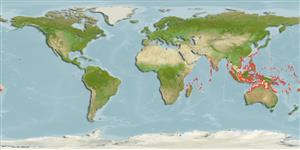>
Eupercaria/misc (Various families in series Eupercaria) >
Lethrinidae (Emperors or scavengers) > Lethrininae
Etymology: Lethrinus: Greek, lethrinia, a fish pertaining to genus Pagellus.
More on author: Valenciennes.
Environment: milieu / climate zone / depth range / distribution range
Ecologia
marinhas associadas(os) a recifes; não migratória; intervalo de profundidade 4 - 35 m (Ref. 90102). Tropical; 30°N - 21°S
Indo-West Pacific: Sri Lanka to the Marshall and Solomon islands, north to the Ryukyu Islands, south to northern Australia.
Tamanho / Peso / Idade
Maturity: Lm ? range ? - ? cm
Max length : 35.0 cm TL macho/indeterminado; (Ref. 2295); common length : 29.0 cm SL macho/indeterminado; (Ref. 37816)
Espinhos dorsais (total) : 10; Raios dorsais (total) : 9; Espinhos anais: 3; Raios anais : 8. Body is brown or tan, with scattered irregular small black blotches, a large oblong black blotch below soft-rayed portion of dorsal fin and bordering below the lateral line. The fins are pale or pinkish.
Solitary or in groups (Ref. 90102). Inhabits shallow seagrass beds, reef flats, lagoons, and sandy areas near coral reefs. Feeds on benthic invertebrates and small fish. Also caught with beach seines and handlines and is marketed fresh (Ref. 9775).
Ciclo de vida ou comportamento de acasalamento
Maturities | Reprodução | Spawnings | Egg(s) | Fecundities | Larvas
Carpenter, K.E. and G.R. Allen, 1989. FAO Species Catalogue. Vol. 9. Emperor fishes and large-eye breams of the world (family Lethrinidae). An annotated and illustrated catalogue of lethrinid species known to date. FAO Fish. Synop. 125(9):118 p. Rome: FAO. (Ref. 2295)
Status na Lista Vermelha da UICN (Ref. 130435)
Ameaça para os humanos
Harmless
Uso pelos humanos
Pescarias: pouco comercial
Ferramentas
Relatórios especiais
Baixar XML
Fontes da internet
Estimates based on models
Preferred temperature (Ref.
123201): 26.2 - 28.9, mean 27.9 °C (based on 396 cells).
Índice de diversidade filogenética (Ref.
82804): PD
50 = 0.5000 [Uniqueness, from 0.5 = low to 2.0 = high].
Bayesian length-weight: a=0.01318 (0.00806 - 0.02156), b=3.00 (2.87 - 3.13), in cm total length, based on LWR estimates for this species & Genus-body shape (Ref.
93245).
Nível Trófico (Ref.
69278): 4.0 ±0.64 se; based on food items.
Generation time: 1.9 ( na - na) years. Estimated as median ln(3)/K based on 2
growth studies.
Resiliência (Ref.
120179): Elevada, tempo mínimo de duplicação da população menor que 15 meses (K=0.5-0.7).
Fishing Vulnerability (Ref.
59153): Low vulnerability (25 of 100).
Nutrients (Ref.
124155): Calcium = 58.4 [39.8, 93.9] mg/100g; Iron = 0.962 [0.622, 1.426] mg/100g; Protein = 20.4 [17.8, 22.6] %; Omega3 = 0.139 [0.096, 0.203] g/100g; Selenium = 36.7 [22.7, 62.9] μg/100g; VitaminA = 31.3 [6.7, 176.2] μg/100g; Zinc = 2.14 [1.59, 2.81] mg/100g (wet weight);
